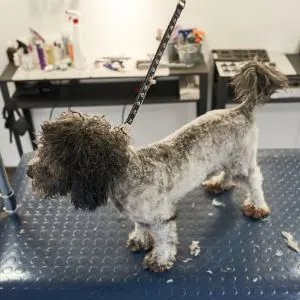Ever since the first Labradoodle was bred by the Royal Guide Dog of Australia, they have been a popular choice for people who longed for the companionship of a dog but are allergic to dogs.
Not only is the Labradoodle considered to be hypoallergenic, they also shed less than a traditional Labrador Retriever. Plus they are billed to have hybrid vigor and look like living teddy bears.
Just their looks alone make them irresistible.
But they are not without their issues. No dog is perfect although many breeders try to make you think that the Labradoodle is.
In this post we will look at some of the things that might make you think twice before going out and getting a Labradoodle.
The purpose of this post is not to scare you or try to change your mind. It is to give you an honest look at what living with a Labradoodle is really like.
Remember getting a Labradoodle is a 10 to 15 year commitment.

Reasons Why You Shouldn’t Get A Labradoodle
1. Labradoodles need a lot of training
All dogs require training. But many irresponsible breeders will bill the Labradoodle as so easy to train they seem to train themselves.
This is just not true. Even the easy going Labradoodle can be a challenge to train if you don’t know the secrets on how to train a puppy.
Plus, there are phases that all puppies go through in their first year that can make you feel like they will never be trained.

Terrible twos
The first of these times comes between the ages of two months and four months. I call this time the terrible twos. This starts around the time they turn two months old and lasts for about two months.
During the terrible twos your puppy is going through a lot of changes. At eight weeks most puppies go to live with their forever family. It is the first time they are away from their mother and siblings. It also means having to learn new house rules, like where they can go potty.
If you don’t have time to devote to training your puppy, including potty training and puppy socialization, you should think twice about getting a puppy.
A better option is to look for a Labradoodle Rescue that is already trained.
The terrible twos are also when they they start their second phase of teething. During these two months they will lose their baby teeth and grow most of their adult teeth.
This is an uncomfortable process for your pup and they will try to chew anything they can get their mouths on to help ease the pain.
Puppy biting is yet another problem most people have to deal with during the terrible twos. It is important that you do not let them think biting is ok.

Puppy Blues
As you can see, the terrible twos can be a trying time with your puppy. It often leads many new puppy parents getting the puppy blues.
But this is just a phase. With proper training you will be able to overcome all these issues.
If you are new to having a puppy I suggest going to a puppy training class. There they will teach you how to train your puppy. Make sure they require proof of puppy vaccinations to keep your puppy safe.

Terrible Teens
Just when you think your puppy is fully trained they will reach their terrible teens. This time will differ based on the adult size of your puppy. Small dogs will mature sooner than larger ones.
You will know when you hit the terrible teens because they will stop listening to you. This is the time you need to reinforce their training.
But fear not, with consistent training you will get through this phase as well.
It all comes down to having the time and patience to train your puppy. If you devote the time to training your puppy when they are young, you will be rewarded with a wonderful companion for many years to come.
2. Can suffer from separation anxiety
Doodles in general tend to suffer from a higher rate of separation anxiety than other dog breeds and Labradoodles are no different. Due to their highly sociable traits they do not do well when left alone for long periods of time.
They need to be around people. Both the Poodle and Labrador Retriever were bred as hunting dogs. This meant they spent most of their days alongside their owners. Their desire to be with their family has not changed even though their role in our lives have.
Of course the trait that makes them want to be with us all the time is what makes them such a great family dog. That is when the family is around, but can be a big headache for an active family that is always on the move.
The good news is that since the Labradoodle is a friendly pup that loves to be out and about, they make it easy to take them with you. Plus, more and more places are becoming dog friendly.
Of course there are times that you simply can’t take them along. For these times you want to start training your puppy to be alone some of the time.
If you need to leave them alone during the day sending them to doggy day care or getting a dog walker can help with the separation anxiety, but that can be expensive.

3. The Labradoodle has a high energy level
When you combine two high energy breeds, like the Poodle and Labrador Retriever you end up with a high energy crossbreed.
Both of these purebred dogs were developed to spend time in the fields alongside their owners. Their main purpose was to flush out prey or to retrieve their owner’s catch. This required a lot of energy and stamina on the part of the dog.
But in today’s world, dogs that live their life as the family pet do not need that same level of energy. However, just because they don’t need it, doesn’t mean they don’t have it. They still have close to the same amount of energy that was bred into the parent breeds years ago.
This excess energy needs to be burned off each day. To do this you will need the time to keep them active and happy.
They not only require a lot of exercise (like long walks and playtime in the yard or park), they also require mental stimulation in the form of training or interactive games.
Without adequate exercise and mental stimulation they will begin to develop bad habits or decide to entertain themselves in ways that you generally would not approve of.
Bad habits can include, rummaging through the garbage, barking at people as they walk by your home or chewing on inappropriate items, like your brand new shoes.
Who is right for the Labradoodle?
Of course their energy level is less of a problem if you have an active family that can play with your dog for a few hours a day, or go for long walks.
But if you or your family are too busy to pay attention to a dog or if you need to leave the dog home alone for long periods of time, a Labradoodle is not the right dog for you.

4. The Labradoodle is high maintenance
There’s a common misconception that doodles are low maintenance. I think this comes from two main ideas about the doodle.
One is that they do not shed and two that they are easy to train. We already discussed their training needs so lets focus on the shedding.
While a Labradoodle might shed less than a Labrador Retriever, they still shed. The main reason why people say their doodles don’t shed is because of all the grooming requirements.
Doodles with long, wavy fur need to be brushed a few days a week (daily would be better) to prevent their fur from matting.
If you don’t do this at least a few times a week their fluffy coat will become a mess quickly and they may need to be shaved down.
Plus, it’s uncomfortable for a dog to have a matted coat. The matted fur can start to pull on your dog’s skin causing irritation.
If you are brushing your doodle often, like you should, you are pulling off all the fur that would normally fall on the floor.
Even if you don’t brush them daily the loose fur will still fall out, but instead of dropping to the floor it will become tangled in the curly fur and start to mat.
If your Labradoodle has a straight or wired coat they will need less maintenance, but then they will also shed more.
So in the end, the time you are saving by not having to vacuum up dog fur is really just traded for the increased time you need to maintain their coat.
The problem with wet dogs
The Labradoodle’s curly coat also requires extra care when taking them out on raining days or taking them in the water. Since both the poodle and Labrador are water dogs, Labradoodles love the water but their fur does not.
A wet doodle can quickly turn a mat free pup into a matted mess after just one short walk in the rain.
Tips to deal with the maintenance
You can cut down on the daily maintenance by keeping their fur short but then you also lose the fluffy look and feel so many people want.
Plus, keeping their fur short means frequent trips to the groomer or learning how to groom them yourself. Both of these things bring us to the next point. Doodles can be expensive to own.

5. Can be very expensive
Labradoodles are both expensive to buy and also to take care of throughout their lives.
Due to the popularity and high demand for the Labradoodle, they cost more to buy from a breeder than either a Poodle or Labrador Retriever.
The average cost of a well-bred Labradoodle, whose parents have been genetically health tested, is between $3,000 and $3,500. A well-bred Labrador Retriever costs between $1,500 and $ 2,500.
The Labradoodle will also cost more in yearly upkeep costs than a Labrador Retriever.

Professional Grooming
Although all dogs require food and trips to the vet to keep them happy and healthy, the Labradoodle also requires expensive professional grooming.
Depending on where you live and the size of your pup, a trip to the groomer can easily cost between $65 to over $100. That doesn’t include a tip. Nor does it include extras like dematting your doodle which is a common charge.
Your doodle will need to visit the groomers every 6 to 8 weeks to keep their fur in good shape.
If you add that up for a year it will cost you at least $600 for grooming expenses alone. That is on top of food, toys, chews and vet bills.
On top of the groomer fees you will also need to purchase a quality slicker brush and poodle comb to maintain their cost in-between visits.
To keep grooming costs down, make sure you don’t let their fur become matted. You can also keep their fur short or choose a smaller dog like the mini Labradoodle.
If you are looking for a mini doodle you may want to check out the mini Goldendoodle, mini Bernedoodle, Cockapoo and Mini Cavapoo
Another option is to groom them yourself. This is what we finally decided to do after going back and forth for a while.
However, the initial cost of equipment which includes a good dog clipper, scissors, hairdryer, table, etc. is around $1,000.
That’s almost two years of professional grooming cost. Plus it can take a couple of hours to get through the process.
It’s not easy either. There is a lot of patience and skill needed to groom a dog.

6. Allergies
You have probably already heard the story about how the Labradoodle got their start. But in case you haven’t here it is. Bear with me for a moment, there is point to this story.
It all started in Australia when a woman in Hawaii reached out to the Royal Guide Dog Association of Australia. She was looking for a guide dog that would not trigger her husband’s allergies.
They first tried to train a poodle as a guide dog, since the poodle is known to be hypoallergenic. But after trialing 33 different standard poodles, they decided that the poodle did not have the right temperament for the job.
So the next idea was to breed a standard poodle to one of the Guide Dog Association’s best Labrador Retrievers. The hope was that the combination would result in a puppy that would pass the husband’s sniff test.
As it turned out, only one of the three puppies that resulted from the pairing didn’t trigger the husband’s allergies.
The purpose of this story is to show you that not all Labradoodles will be allergy friendly to all people. Everyone has a different trigger when it comes to allergies.
If the main reason to get a Labradoodles is because they are hypoallergenic you may be disappointed with your decision. If you really need an allergy free dog the only way to find one is to spend time with them before committing a lifetime.
7. Can be mouthy
As I mentioned already both the Poodle and Labrador are retriever type breeds. This means they have been bred to use their mouth to do their job.
While both tend to have a “soft mouth” they also have a tendency to use their mouths to communicate.
A soft mouth means that they have been taught not to clap down hard on what they are carrying. This is to prevent damage to the prey they are retrieving.
It’s not unusual for a Labradoodle to use their mouth to grab a person or tug on their clothes to get attention. Especially when they are puppies.
While they mean no harm it can be scary, plus they can leave marks. This is especially an issue when young children are around young Labradoodles that have not learned the proper way to use their mouths yet.
If you decide to get a puppy, you will need to watch them at all times when they are around young children. You may also want to wait until your kids are older before bringing home a puppy.

8. The Labradoodle is prone to certain health conditions
Although the Labradoodle is billed as being healthier than purebred dogs due to “hybrid vigor” this is not always the case. We will discuss Hybrid Vigor and what it really means in the next bullet.
The reason hybrid vigor does not always apply is that both the Poodle and Labrador share some of the same health issues; like Hip Dysplasia and allergies. Plus in some cases you don’t need to pass down the genetic conditions from both parents for the puppy to be affected.
Here is a list of the top ten common health conditions for each breed that is part of the Labradoodle.
| Poodle | Labrador Retriever |
| Addison’s Disease | Obesity |
| Hip Dysplasia | Hip Dysplasia |
| Cushing’s Disease | Osteochondritis Dissecans – soft joints |
| Epilepsy | Eye Disease |
| Bloat | Epilepsy – seizures |
| Allergies – skin allergies | Allergies – environmental allergies |
| Cancer | Bloat |
| Blood Clotting Diseases | Tumors |
| Kidney Disease | Exercise-Induced Diseases |
| Cataracts – usually progress to blindness | Heart Disease |
9. The truth about hybrid vigor
Hybrid vigor is a term that breeders like to use with doodles. But hybrid vigor is associated with dogs that have several breeds in them. The belief is that the more diverse genetically a dog is, the less likely they will suffer from genetic health conditions.
Since the American Labradoodle only has two breeds that share some of the same health concerns, it is less likely that they will benefit from hybrid vigor.
If you really want a dog with hybrid vigor you should pick a doodle whose parents do not share the same health concerns.

10. They don’t all have a soft wavy coat.
As I mentioned at the beginning, it’s the teddy bear look that attracts so many people to the Labradoodle.
But not all Labradoodles will inherit the long, soft fleece coats that give them that look. Some will instead inherit a long, straight wiry coat.
If the teddy bear look is important to you, you should choose either an F1b Labradoodle or a true Australian Labradoodle.
11. Poor breeding
Wally Conrad is often quoted as saying in an interview with Stanley Coren PhD., DSc, FRSC, that he regrets breeding the first Labradoodles. He goes on to say that many Labradoodles are either in poor health or crazy. The reason for his regrets and the poor health is all related to the poor breeding practices that followed the Labradoodle craze.
As with purebred dogs, greed took over sound breeding practices when it came to the Labradoodle. Once they grew in popularity, puppy mills and backyard breeders started pumping out puppies as fast as they could to keep up with the demand.
This is not unique to Labradoodles, Goldendoodles or any of the other doodle and designer breeds. You will find poor breeding practices with any of the popular purebred dogs that came before the doodles.
It’s not uncommon to hear people say that the doodle they had 10 years ago was much better behaved than the one they have now.

12. They can cause a mess
The Labradoodle may seem like the perfect choice for people who want a clean house. But they are not as clean as you may expect. Although most will shed less than a purebred Labrador Retriever, they do still shed.
Plus the long fur under their chin causes them to “drool” after drinking water.
Technically, they are not drooling. Unlike other breeds that are known for drooling, like the Newfiedoodle, Labradoodles do not have the jowls and loose lips that cause excessive drooling.
But they are still known to leave puddles around their water bowl or drips of water all over the place.
The reason for this is the long fur around their mouth that dips into the water bowl while they drink.
There is a solution.
You may have noticed that Poodles often have their faces shaved. This prevents the long fur on their face from falling into the water bowl. You don’t need to shave their face to get the same results. Just keeping their fur shorter under their chin will help with the mess.
Another option is the Slopper Stopper. It’s a special bowl that keeps the fur out of the water. Many Labradoodle owners recommend this option.

What type of person is right for the Labradoodle?
The best person for a Labradoodle is:
- Someone who is looking for a full time companion to share their life with.
- A person or family that doesn’t mind the daily grooming required to keep the dog’s coat mat free
- An individual or family that enjoys an active lifestyle and can bring their pup along.
- And someone who doesn’t mind some drool and dirt in their home.
If you are not sure if a Labradoodle is right for you, take a moment to learn about the Goldendoodle, Newfiedoodle and the Bernedoodle.
Or if you are trying to decide between a Standard Poodle or Labradoodle, Check out our post for a detailed comparison.


Jonathan Bate
Saturday 16th of September 2023
I beg to differ... with so many points here that I do not recognize my Labradoodles in most of your description. I have had 2. They are both intelligent and very friendly. They have straighter coats and need minimal grooming. They both shed somewhat, but most of it comes out with their 2-minute daily brushing after their morning walk. They were both trained to be alone and have no problem with hours alone at home a few times a week. They were well-trainable and learned quickly. They are very friendly to everyone. I groom them myself with $50 worth of equipment.... and the coat growth is such that 3 times a year is enough. I cannot see the many negative points from your article in my dogs.
Bonnie
Monday 18th of September 2023
Hi Jonathan,
Thank you for you stopping by and giving a different point of view. As you pointed out all Labradoodles are different. Some are easier to maintain and train, while others are not. This list definitely does not describe every Labradoodle, but some may have a couple of things on this list that future pet owners should know about before bringing one home.
In our case, it takes us about two hours every 4 weeks to maintain a reasonable hair length on our small doodle. The equipment cost was a few hundred dollars. But we love her dearly and couldn't imagine life without her.
It sounds like you found the perfect dogs for you. I wish you many happy years with them!
Karen z.
Sunday 2nd of July 2023
I agree - and would add the following observations: Why not get a true breed - one that has replicated seven generations and beyond the same characteristics? Why not get an Irish Water Spaniel from an ethical CHIC certified breeder - the breed that Conrad was aiming to emulate? Why pay thousands for a mutt when you can get a sound reliable temperament and physique? Never ceases to amaze what sheep people are.
Bonnie
Tuesday 11th of July 2023
Hi Karen,
Thank you for stopping by and taking the time to leave a comment.
As you pointed out, a purebred, is a dog that breeds true after many generations of breeding. But this also points to the fact that most purebred dogs today were developed by mixing different types of dogs to create one with the desired qualities in the past.
Even the Irish Water Spaniel’s DNA results suggest they are part Poodle, Barbet and Portuguese Water Dog.
In 2022, the AKC recognized two “new” breeds. Showing that the world of purebreds continues to evolve. It’s possible that at some point in the future the Labradoodle will also be recognized by the AKC.
I think the real issue with crossbreeds is 1. Knowing the truth about what you are getting into and 2. As you pointed out, finding an ethical breeder that does the necessary health testing.
Unfortunately, too many breeders are just looking to get on the latest gravy train, which happens to be doodles. This resulted in misinformation about the dogs and poor-quality breeding.
Since both the Goldendoodle and Labradoodle have breed clubs with recommended health testing it is possible to find an ethical breeder that does health testing. It’s also now possible to find multi-generation Labradoodles that are more then seven generations removed from the first crossbreeding.
One last thing. I actually looked into getting an Irish Water Spaniel. What I found was that they required way more training, socialization and exercise then we could provide for them. They are also very hard to find in the US as are many of the other purebred dogs that are similar to the Irish Water Spaniel.
Thanks again for stopping by and starting this discussion. Bonnie
John
Saturday 1st of July 2023
You are so right - on all 12 points.